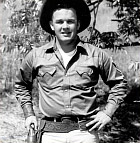
February 8, 1942 — December 10, 2012
The eldest of five siblings, Bob Munden was born in Kansas City, Missouri, to Robert and Dorotha Munden.
In the U.S. Army during WWII, Bob’s father saw brief, horrible action in the Philippines and was awarded a Purple Heart after fire from a Japanese machine gun nearly tore off his left arm and caused other life-changing injuries. Robert Sr. spent 4½ years in different U.S. Veterans hospitals, where surgeons slowly constructed a new elbow using grafts of skin from other parts of Robert’s body. During this time, the family moved to Southern California to be closer to him — and money was scarce.
Bob’s first memories of California are of living in an apartment in Los Angeles and then a home in Anaheim, with his mother and brothers Dan, Phil and Randy – and his sister Chery, the youngest. Robert Sr. made certain Santa gave Bob a BB gun when he was six years old.
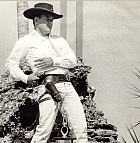
Some years later, by working odd jobs around the neighborhood, Bob earned enough money to buy himself a pellet rifle. He spent every free moment in the walnut and orange groves in Anaheim shooting crows to collect bounty money. One day when he was busy hunting, Bob saw heavy equipment tearing out his beloved orange groves in the spot that would become Disneyland. On opening day, because the new park wasn’t yet completely fenced off, Bob was able to walk in through the Adventure Land Jungle Boat Ride to witness Walt Disney cutting the tape for the grand opening on Main Street.
Whenever possible, Bob’s family spent time at the beach, in the desert or in the mountains of Southern California, where Bob spent lots of time in the wilderness exploring and practicing his shooting skills with guns and bow.
When Bob was in fifth grade, his father traded a shotgun for two double-action revolvers. Bob practiced Fast Draw using a cap gun holster, and entered his first Fast-Draw tournament, shooting live ammunition, when he was just 11 years old. In 1953, the professional sport of Fast Draw, sometimes called Quick Draw, was just a few men in the desert who met once a week at a garbage dump to shoot. The entry fee was a dollar and winner took all. Bob did not win his first tournament, but he was inspired, partly by the love of movies and television westerns, and became a dedicated Fast-Draw enthusiast.
In 1954, Bob’s family moved to Big Bear Lake, California, a resort area in the San Bernardino Mountains. Bob attended junior high and then graduated from Big Bear High School in 1960, where he had perfect attendance for all four years, was voted Best Dressed all four years, wearing clothes he bought at the Good Will store – and won the annual talent competition twice playing his trumpet, and once while playing drums in spite of not ever having music lessons aside from a very brief stint of accordion lessons when he was very small. He played in the band, but refused to learn to read music. In football, Bob played offense and defense. His senior year, Bob helped the Big Bear Bears by blocking three punts and intercepting four passes in a single game. As a result of this performance, the school presented him with “The Silver Buckle Award.” Becky still has the engraved, oval-shaped buckle.
Bob also excelled at basketball. Though certainly not tall at 5′ 7 ½” , Bob was the guard and ball handler — and the best free-throw shooter in the conference. Big Bear High School was famous for its basketball program. The small-town school was categorized as a C Class school, but the basketball team sometimes played AA Schools in tournaments — and won.
When he wasn’t on the basketball court early in the mornings or late in the afternoons, Bob fished and hunted deer, rabbits, ducks, quail and other birds with a bow, with shotguns, rifles and hand guns to help feed his family. Shooting archery helped Bob develop his instinctive shooting skills. He also practiced Fast Draw and became very proficient.
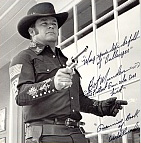
When Bob was still just a kid, Jeff Cooper, a retired U.S. Marine Corps Lt. Colonel and a famous gun writer who wrote for Guns & Ammo Magazine. Cooper also created the sport of combat style shooting and organized a shooting club at Big Bear Lake. Bob began competing with his Iver Johnson, breakdown, double-action .38-caliber revolver — and cap-gun holster. The belt? It was a sash from a bath robe. Munden raked pine needles, cut wood and did other odd jobs to buy ammunition. He also did yard work for Col. Cooper in exchange for using Cooper’s Colt .45 Single-Action Revolver. Bob won his share of duels in the Leatherslaps and, with Cooper’s gun placed 2nd when Munden was 16.
Bob bought his own Colt single action in 1959 for $75.00 after making payments on it all summer. While working in Los Angeles for his uncle over the following summer, Bob witnessed a Fast-Draw tournament where participants used blank ammo. Having had experience shooting Fast Draw with real bullets, at first Bob thought blank tournaments were silly. But then he saw the place for that type of competition, which could be held safely in many locations – and he saw the skill required. A naturally fierce competitor, Bob took a keen interest in the sport for the challenge. Of course the money prizes also appealed to him. Once he entered his first blank tournament, there was no stopping him.
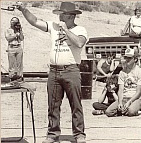
In the beginning, the only event shot was Walk and Draw Level with Blanks, where competitors walked toward one another and reacted to a signal light in the middle. They started approximately 110 feet apart. The difficult skill was to react to the signal light, draw and fire your gun while walking toward your opponent — and shoot a level shot before your competitor could
There were hand judges to make sure shooters did not touch the gun, the holster, or their body prior to the draw. At that time, the gun hand had to be at least six inches from the gun. For each shooter, there were also three level judges who determined if the shot was level enough to hit a man between the knees and neck.
Bob was used to thumbing the single action with live ammunition, which was slower than the fanning style used by the fastest blank competitors. Once introduced to Fast Draw with blanks, he immediately began practicing and developed his own fanning style of draw, shooting thousands of rounds with blank ammunition every week. By 1961 Bob Munden was winning just about every shoot he entered, and eventually set 18 world records, including Fastest Time in the Walk and Draw Level event at 15 hundredths of a second, using a .45 caliber stock-weight Colt.
Solo, Bob began entertaining with guns at age 20
Very early in his competition career, Bob tore his gun apart and taught himself, with determination and experimentation, how to build guns that could withstand the extreme stresses of Fast Draw. He coined the term Race Gun to describe a gun that looked stock, but was actually one Munden customized using what he came to call Six-Gun Magic, to withstand the rigors of intense use, like a race car built to stay together at maximum speeds for extended periods. Bob’s famous custom action work, now done by Jeff Ault, results in guns that are nearly unbreakable with crisp triggers and super smooth actions for shooting live ammunition, wax or blanks. Munden also developed key innovations for the single action that he used as a master gunsmith, including his creation of the Munden Premier Action. Bob also designed Munden Recoil Control Grips.
Becky Munden first saw Bob in 1961 when she went to a Fast-Draw tournament to watch her brother compete. Her brother, Bill Lewis, was an excellent Fast-Draw competitor.
While at the tournament Becky saw “Bobby Monday.” as some called him then, and became a fan of the “really cute guy” who was “winning everything.” Shy Becky started participating in Fast Draw about a year and a half later and became a champion in her own right. She married flamboyant Bob in 1964 after a three-month courtship. On their honeymoon they went up to Concord, where Bob won the California State Championships for the 2nd year in a row and brought home many trophies, money and a pair of Colt Centennials. Footage of Bob and Becky with those tournament trophies is included in “Bob Munden: Outrageous Shooting” on DVD.
By 1968 Bob and Becky had two daughters, Natalie and Mitzi. The family was living in Bishop, California, and contemplating their future. Bob and Becky decided to try to make a living doing what Bob did best — and that was shooting. They developed a shooting show using blanks and made their debut as a shooting duo at the Tri-County Fair in Bishop. In 1969, an agency that booked school assembly programs hired Bob and Becky. The Mundens packed up their two little girls in a Plymouth station wagon and set off to perform at grade schools and high schools, where they entertained students with Fast Draw, talked about the myths of the Old West and, taught the importance of gun safety.
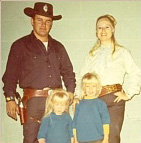
After the first year, Bob and Becky were able to get into a motor home, which made life on the road a lot easier. They performed two to three shows a day, usually in different towns. It was a grueling schedule, but they enjoyed entertaining and traveling. After two years of school assemblies, they quit and Bob started booking shows himself. They made significantly more money, cut their expenses and experienced far less stress. Over the years, people frequently approached Bob and Becky after performances to say they saw the show when in grade school. Often these fans were accompanied by their children or grandchildren.
In 1975 Bob and Becky headed east to work at amusement parks like Six Flag’s Great Adventure, in shopping malls and at auto dealers. In 1976, the American Can Company, which made Dixie Cups, was developing Guinness Book of World Records cups. The company needed an angle to promote the product, and an agent out of New York contacted Bob. A Dixie Cup featured a drawing of Bob and listed his World Record of 21/100ths of a second at 21 feet, hitting a man-size silhouette target with live ammo, as well as his five-shot, total time with blanks at eight feet in 1.06 seconds.
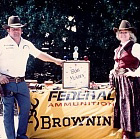
As part of the promotional tour, Bob appeared at the opening of the first Guinness Book of World Records Exhibit Hall, which opened in the lower level of the Empire State Building in New York in 1976. During the grand opening festivities, Bob, in front of the cameras, set a new speed record. He drew his single action from the holster, cocked and fired it in less than two one-hundredths of a second – or less than one half of one half, of one tenth, of one second. Becky came up with that description to help people understand such incredible speed.
Bob and Becky toured the country, appearing on local and national television talk shows. Bob promoted the Dixie Guinness World Records Cup by using it during exhibitions. He would place the cup on his fanning hand and mention that it was a Dixie Guinness World Record Cup — and then blow it apart before it dropped. The promotion was very successful.
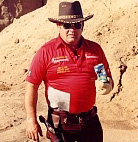
In 1978 the Mundens moved to Butte, Montana, where they could buy a permanent home and allow their daughters, then ages 13 and 12, to remain in one school district through high school – and where the family could live close to hunting and fishing resources while Bob and Becky continued to tour nationally and overseas with their stage show, which, because they used blanks, was safely performed indoors or at outside venues. They thought Butte had character and claimed it as their home town.
Soon after their move to Big Sky Country, Bob and Becky brought the sport of combat shooting to Montana, developing and hosting in Butte The Montana State Practical Handgun Championships, otherwise known as The Great Northwest Shootout. It was Becky’s idea for the plates to fall, so it would be even more exciting for spectators. Due to Bob’s effective style of promotion, the multiple-event competition drew sponsors and featured man-against-man competition, trophies and great prizes — and amenities for spectators including bleachers, a lunch truck and outhouse facilities. The Great Northwest Shootout drew competitors from across Montana and several western states.
A few years later in the mid-1980s, Bob and Becky developed a shooting exhibition to include shooting Fast Draw with blanks as well as live ammunition, inventive trick shots (that are no trick at all, but very difficult and entertaining) — and extreme accuracy and long distance shots that are featured on DVD. The Mundens performed their shows at various shooting clubs, at the Steel Challenge, The Bianchi Cup; annually at End of Trail, the premier event of Cowboy Action Shooting, for Safari Club International, and at hundreds of other locations.
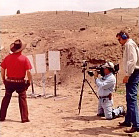
In the 1980s, when Bob realized the then new sport of Cowboy Action Shooting could not grow if the participants’ guns weren’t customized to hold up, he started doing gun smithing for other shooters using the skills he developed and honed during his Fast Draw competition years. Bob and Becky launched Munden Enterprises, Inc. and Bob became Cowboy Action Shooting’s first gun smith.
Bob appeared on countless television shows over the years, a few of which include The Steve Allen Show, Ripley’s Believe It or Not!, You Asked For It!, Ordinary, Extraordinary; David Frost’s Guinness Book of World Records Special, The World’s Most Awesome Acts, To Tell the Truth, CNN News, American Shooter, Shooting USA’s Impossible Shots and, Stan Lee’s Superhumans on The History Channel to name a few. Bob and Becky appeared on television programs shown around the world — and on hundreds of local news broadcasts across America. They also performed in person at fairs and shopping malls, amusement parks, at car dealerships, conventions, sport shows, banquets, grand openings and private affairs.
In 1990, producers of the television program American Shooter signed Bob to be one of their featured exhibition shooters. The show gave Bob the opportunity to showcase other skills besides Fast Draw, and he did – by making all kinds of incredible shots with live ammunition like shooting an aspirin off the head of a nail without hitting the nail, splitting a playing card in flight, doing all kinds of other, absurdly-difficult shots he thought up, like shooting the tobacco out of a cigarette and numerous other exhibition shots that had never been done before – all with handguns. Bob also did super, seemingly impossible shots with all types of guns, including rifles and shotguns.
Fans frequently called or wrote in with suggestions for more types of outrageous shooting they would like to see Bob attempt.
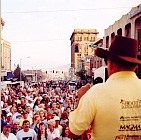
In 1993, Bob introduced Munden’s School of the Fast Gun™, which took place annually in Butte, Montana. Students from all over the country attended, some coming back year after year.
In 2000, Bob was able to capture on video his successful hunt of an Alaska Brown Bear with an iron-sighted hand gun, the .454 Casull by Freedom Arms.
In 2004, Bob showed Bond Arms, Inc. what their double-barrel derringer could do. Using the .45-calibur, 2 ½” Bond Derringer, Bob split a playing card, shot a clay disk in the air, hit a 10″ balloon target 50 yards away – and shot two small, balloon targets (eight feet apart) so quickly that the two shots sounded like one. This with a stock Bond derringer.
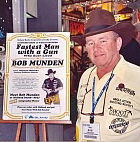
While he was in his work shop every day, he found himself talking on speaker phone with all kinds of people and answering questions about the trends in the shooting sports, about the history, of Fast Draw, CAS, Mounted Shooting and Cowboy Fast Draw. He discussed hunting, gun safety, gun rights, shared his strongly held beliefs about what it means to Shoot With Honor in competitions – and reminisced about the western movie heroes he and Becky grew up with.
Until his death, Bob Munden was in his shop regularly doing action and trigger work on single actions, Smith & Wesson double actions and Bond Derringers. For single-action revolvers, he offered two options. Option #1 gunwork included custom action and timing with a crisp trigger. Option #2 was his strong and dependable Munden Premier Race Action. Bob customized guns for shooters all over the world. He dedicated his life to shooting and the shooting sports. Munden was exhibition shooting on camera just eight weeks before he died of a heart attack while riding with Becky as they were on their way back to Butte, Montana. That Bob passed away while on the road with Becky, his traveling and shooting partner of many, many years, seemed more than appropriate.
Celebration of the Life & Times of Bob Munden
A celebration of the life and times of Bob Munden took place Saturday, June 12, 2013, followed the next day by a 70-shot six-gun salute at the Butte Gun Club in Rocker, five miles from Butte.
According to Munden’s wife and shooting partner Becky Munden, the public was invited to attend the event, hosted by the Butte Gun Club and the Munden family.
The six-gun salute began at high noon, in keeping with the tradition in western movies. Family members and special guests used single-action revolvers, also known as six-guns, fired a total of 70 shots – one for every year of Bob’s life.
“Bob was skilled at shooting all kinds of guns,” Becky said, “but the single-action revolver was his favorite gun to shoot and work on.”
Under a beautiful sky, Becky started things off by stepping up to the firing line and fanning off five rounds, which she counted as the first shots of the salute on Sunday. Close family friend Jeff Ault, also of Butte and the man Bob trained to take over the gunsmithing part of Munden Enterprises, now called Munden’s Six-Gun Magic by Jeff Ault, shot the 70th and final round.
The send-off took place just outside the Butte Gun Club’s historic Schützenhaus (shooting house) where for Shooting USA TV’s Impossible Shots, Bob made some of his most noted exhibition shots using a S&W .38 caliber Model 60 and a .22 caliber buckle gun to shoot targets 200 yards away off-hand (without a scope or rest) to demonstrate that handguns can be accurate even at long-range targets. The Schützenhaus was also the location for Munden’s School of the Fast Gun with blanks and wax ammunition, which was held annually beginning in 1993.
After the close of the weekend’s events honoring Bob Munden, Becky said, “Bob made it possible for us to make a living shooting our cowboy six-guns. Using blanks, and live ammo where appropriate, we traveled all over and were rarely apart.
“Our first show was in Bishop, California in 1968.”
Becky continued, “We competed, supported the shooting sports, taught gun safety at school assemblies and entertained people in live performances or on television, and now YouTube, for a really long time.
“I wanted to honor Bob with this memorial event and give family, friends and fans the chance to do the same.”
Becky has said more than once, “I was so blessed to spend almost 50 years of my life with this very special man.”
A Favorite Munden Fan Post
ImRamro commented on YouTube:
“Bob Munden was my first inspiration and idol. I remember watching old VHS videos of him and was always amazed by his wit and charm. He made shooting look and feel like Christmas morning.”
